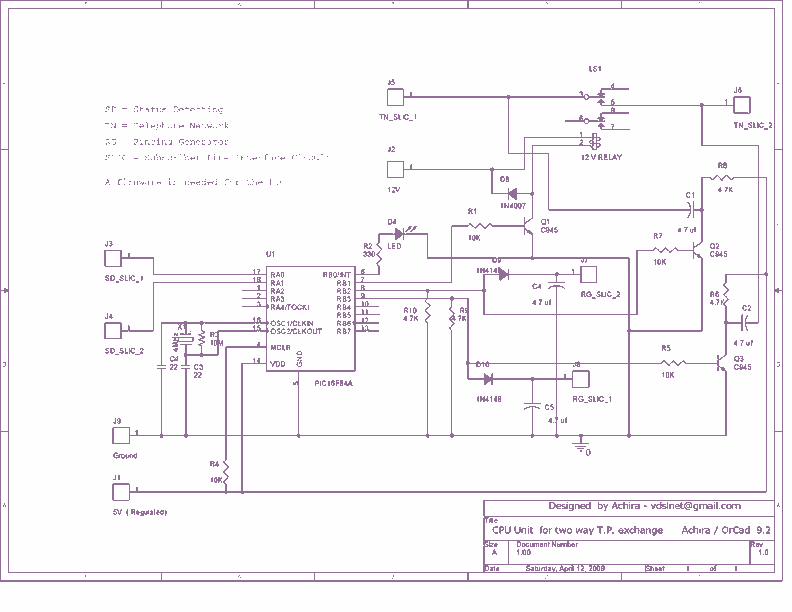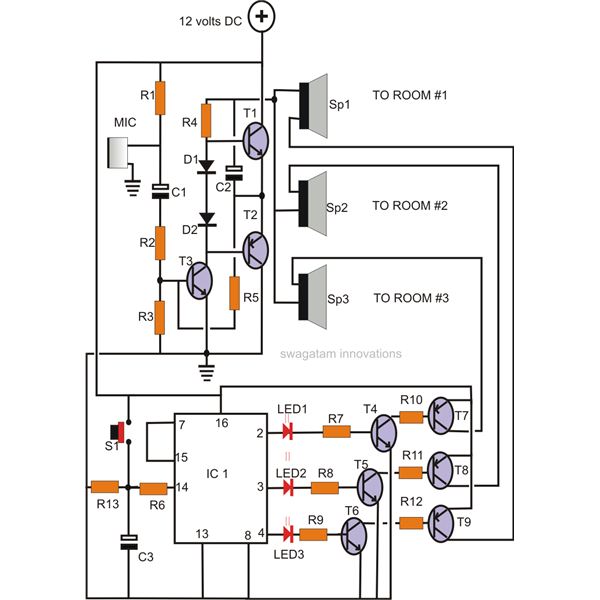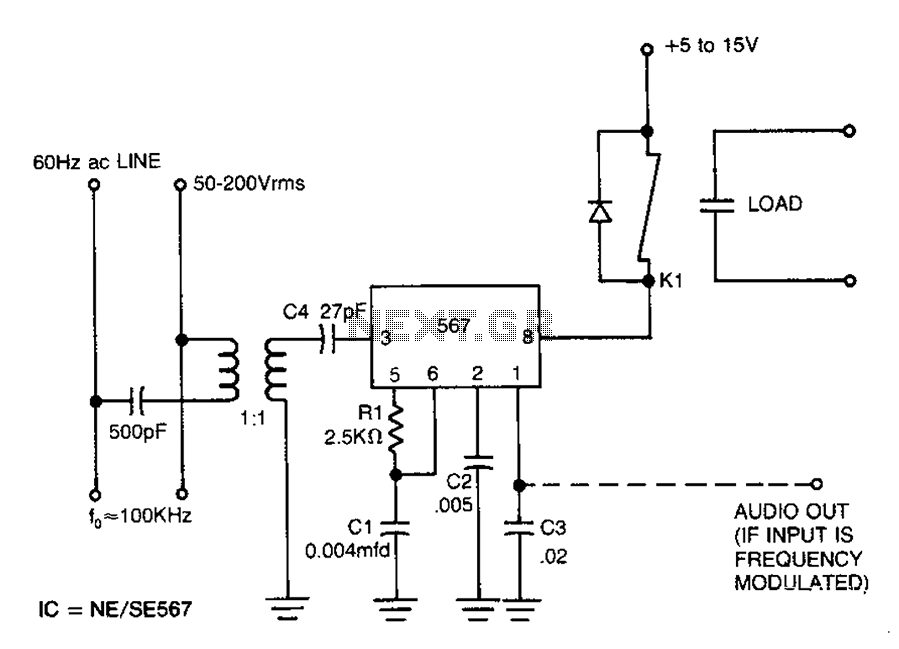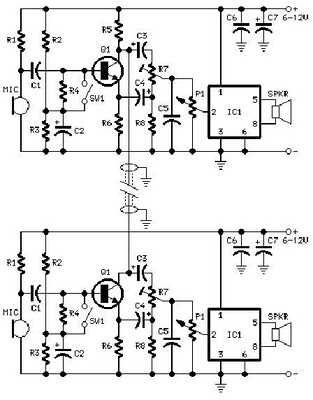
Party intercom
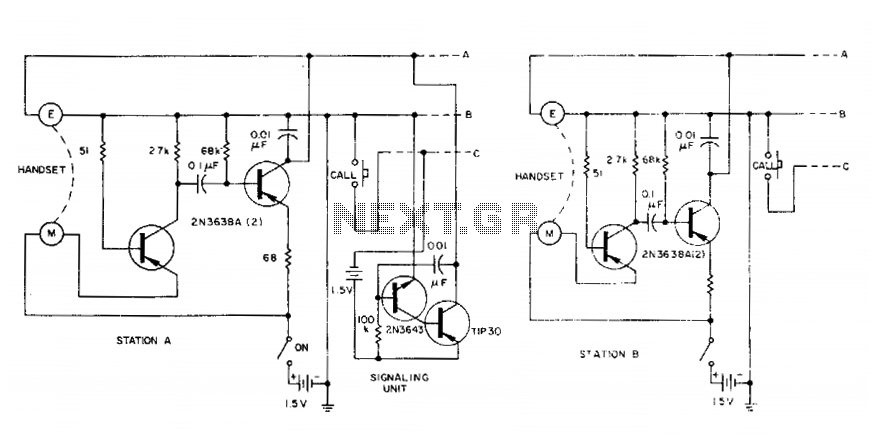
A large number of intercom stations can be connected in parallel. All units share a single signaling circuit for communication. Each station is powered independently by 1.5-V cells for redundancy, although 3-V sources can be utilized for increased signal volume without modifying other components. The carbon microphone from a standard telephone handset at each station connects to a common-base amplifier, followed by a tandem high-gain common-emitter stage that drives the intercom line. All phone earpieces are connected in parallel across this line. Additionally, the signaling circuit, which is also linked across the line, functions as a simple oscillator that activates all the earpieces.
The described intercom system employs a robust architecture suitable for environments requiring reliable communication across multiple stations. Each intercom unit operates in parallel, ensuring that the failure of one unit does not affect the overall functionality of the system. The individual power supply design, utilizing 1.5-V cells, enhances redundancy; however, the option to employ 3-V sources allows for flexibility in audio output levels, making the system adaptable to various acoustic environments.
The use of a carbon microphone, similar to those found in standard telephone handsets, ensures clear audio capture. This microphone feeds into a common-base amplifier, which is advantageous due to its high input impedance and low output impedance, facilitating effective signal transfer. The subsequent tandem high-gain common-emitter amplifier stage further boosts the audio signal, ensuring that it is sufficiently strong to drive the intercom line effectively.
The parallel configuration of the phone earpieces allows for simultaneous audio output to all connected units, ensuring that all stations receive the same audio signal without interference. This design is particularly useful in settings where multiple users need to communicate or respond to signals concurrently.
The signaling circuit's role as a simple oscillator is critical, as it generates the necessary signaling tones or alerts that activate the earpieces. This circuit's efficiency and simplicity contribute to the overall reliability of the intercom system, minimizing the complexity and potential points of failure.
In summary, this intercom system design is characterized by its parallel connection of stations, individual power supply for redundancy, and effective amplification stages, making it a practical solution for various communication needs in larger facilities or buildings.A large number of intercom stations can be tied together. All units are connected in parallel, and the entire system is buzzed by only one signaling circuit. Each unit is powered individually from 1.5-V cells for redundancy. For greater signal volume, 3-V sources can be used for the supplies without changing any other parts of the system. The carbon microphone of a standard telephone handset at each station feeds into a common-base amplifier, and a tandem high-gain common-emitter stage drives the intercom line.
All phone earpieces are in parallel across the line. The signaling circuit, also connected across the line, is a simple oscillator that drives all the earpieces.
The described intercom system employs a robust architecture suitable for environments requiring reliable communication across multiple stations. Each intercom unit operates in parallel, ensuring that the failure of one unit does not affect the overall functionality of the system. The individual power supply design, utilizing 1.5-V cells, enhances redundancy; however, the option to employ 3-V sources allows for flexibility in audio output levels, making the system adaptable to various acoustic environments.
The use of a carbon microphone, similar to those found in standard telephone handsets, ensures clear audio capture. This microphone feeds into a common-base amplifier, which is advantageous due to its high input impedance and low output impedance, facilitating effective signal transfer. The subsequent tandem high-gain common-emitter amplifier stage further boosts the audio signal, ensuring that it is sufficiently strong to drive the intercom line effectively.
The parallel configuration of the phone earpieces allows for simultaneous audio output to all connected units, ensuring that all stations receive the same audio signal without interference. This design is particularly useful in settings where multiple users need to communicate or respond to signals concurrently.
The signaling circuit's role as a simple oscillator is critical, as it generates the necessary signaling tones or alerts that activate the earpieces. This circuit's efficiency and simplicity contribute to the overall reliability of the intercom system, minimizing the complexity and potential points of failure.
In summary, this intercom system design is characterized by its parallel connection of stations, individual power supply for redundancy, and effective amplification stages, making it a practical solution for various communication needs in larger facilities or buildings.A large number of intercom stations can be tied together. All units are connected in parallel, and the entire system is buzzed by only one signaling circuit. Each unit is powered individually from 1.5-V cells for redundancy. For greater signal volume, 3-V sources can be used for the supplies without changing any other parts of the system. The carbon microphone of a standard telephone handset at each station feeds into a common-base amplifier, and a tandem high-gain common-emitter stage drives the intercom line.
All phone earpieces are in parallel across the line. The signaling circuit, also connected across the line, is a simple oscillator that drives all the earpieces.
